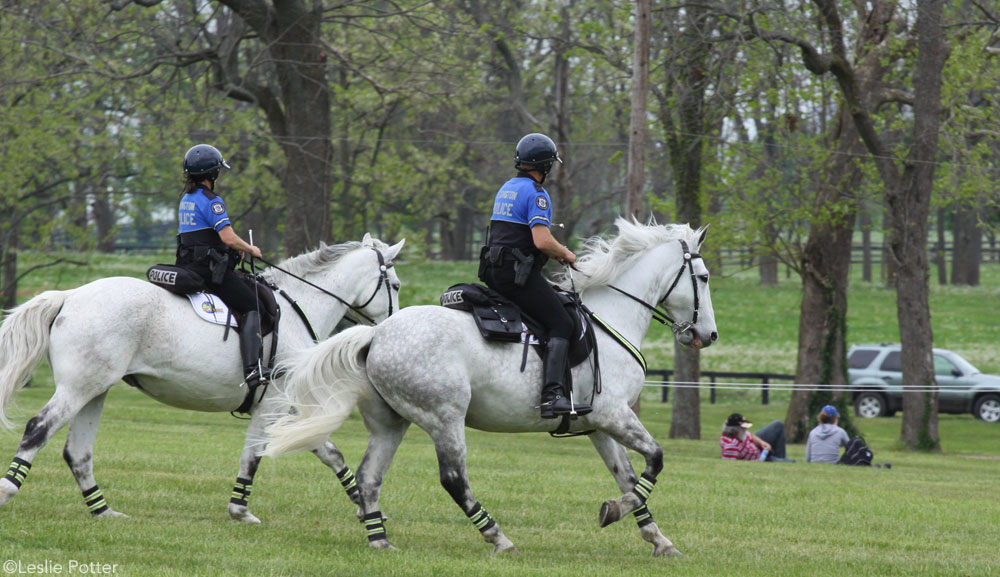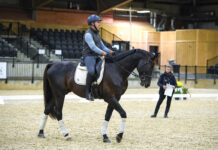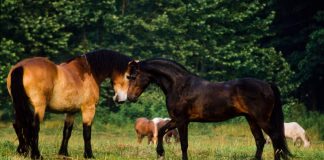Along with their human partners, police horses are conspicuous everywhere from riots to county fairs. But even more than holding the line between crowds and bystanders, horses ridden by mounted police officers seem totally impervious to placards, banners and noise. So how exactly do mounted police units train their horses for street duty? The process takes time and dedication, but any horse and rider team can benefit from what this kind of training provides.

“I don’t like the term ‘bomb-proofing’ because people are like horses and none of us is bomb-proof,” says Capt. Lisa Rakes of the Kentucky Horse Park Mounted Police. “Even with the training, the horses are going to be startled, but the trick is to teach them that while it’s okay to jump in their tracks, it’s not okay to run away.”
Meanwhile, so-called bomb-proofing, or desensitizing horses builds confidence in both horse and rider, says Mary Elena Moran, member of the New York State Police Department’s Mounted Unit, and professional horse trainer whose From Kill Pen to Cavalry program transforms rescued horses into confident police horses then donates the horses to mounted police units.
“Basically, it’s the horse’s nature to be afraid and we’re asking it to do something against its nature,” Moran says. “This training builds the horse’s confidence that you will not ask him to do anything that he cannot do or that will hurt him, and at the same time, helps you build confidence that the horse has been exposed to the things he may come across at a show or on the trail.”
Here’s how to do it:
Start on the ground
According to Moran, horses in desensitization training always do better when their initial training is part of their routine groundwork.
“You have to build a foundation so always start on the ground,” Moran advises. “Then the horse will be much more able to cope with the challenges when you’re in the saddle.”
Create Obstructions
Just about any everyday object can be used in a horse’s training program including an umbrella, ground poles, plastic milk jugs, flags, tarps and even swimming pool noodles, Moran says. Each teaches horses a certain skill.
For example, whether on the ground or mounted, asking the horses to walk over tarps, ground poles or other small obstacles scattered throughout their arena can simulate obstructions its might encounter during a trail ride.
“Also, you can teach a horse to push against an object by replacing poles in the cups of jump standards with pool noodles,” Moran said.
Make a Path
Moran also recommends using jump standards or other obstacles to teach horses to walk through increasingly narrow spaces.
“Take poles [and cups] out of jump standards and walk the horse through,” Moran suggests. “You can teach the horse to walk though narrower and narrower spaces simply by bringing the standards closer together.”
Get Help
The pool noodle exercise also teaches horses to gently “push” its way through groups of people walking in its path. So enlist friends to create small crowds.
“If you can, get help from a group of friends,” Rakes says. “In controlled training, you have the small crowd walk away as the horse moves forward.”
Help from friends can also expose the horse to noises such as loud conversation, laughter, and shouting from onlookers located on the ground, Rakes says.
Throw Things
When it’s possible, get a friend to take part in a training session by throwing light objects toward your horse. Also, have a partner on the ground in the arena open an umbrella someplace where the horse can see it, wave a flag or carry a sign somewhere within the horse’s line of vision.
“Have someone else throw plastic bottles or a plastic bag [in the horse’s direction], and then the person should back away to let the horse win,” Moran suggests. “Then (the horse) can stop and look and investigate (the object).”
“Also, signs that are carried above their heads can seem like predators, so expose horses to flags and banners and signs they might encounter at horse shows and other places,” Moran adds.
Try these exercises on the ground before practicing under saddle. Horses new to desensitization training do better when initially these kind of exercises are performed as part of groundwork, Moran says.
Warm up Well
Meanwhile, Moran believes that horses do best with any kind of training after they have first finished a good warm-up workout under saddle.
“Do the training exercises when the horse is tired, but not so tired that it can’t work any longer,” she says. “Then keep training sessions short.”
Be Mindful
According to Rakes, horses constantly learn from their handlers, and every single interaction between horse and rider yields some result. So she believes it is critical to make sure horses learn appropriate skills.
“Clearly communicate what you want from the horse,” says Rakes, “Be aware that if you put a leg on your horse and he does not respond, then you have told him that he does not have to respond when you apply leg pressure.”
Lose Expectations
Whatever skill is being taught, horses – and people, too – do better when they practice often. So Moran suggests that you practice frequently, without becoming a slave to your expectations.
“You can’t go into the ring thinking that you’re going to accomplish this or that,” she advises. “It’s great if you do, but leave your expectations behind and just practice and end on a positive note when your horse responds the way you want him to respond.”
Partnership Counts
Ultimately, the point of desensitization training is to help both horses and riders build confidence. But it is intended to capitalize on the horse and rider partnership, too.
“Remember, you’re asking the horse to not be afraid and he looks to you for leadership,” Moran says. “The better you become at this, the better he will become, too.”
Liked this article? Here are others you’ll love:
Train Your Horse Like a Police Horse
Careers in the Horse Industry: Mounted Police Officer







I would like to train a horse to be a suitable police horse. Is there a market for police horses ? is there videos or teaching helps that would get me started ? Do American Saddlebreds make good police horses? it possible to get a list of all the police stations that use police horses? How tall do they have to be? Any information you could give me would be appreciated. I